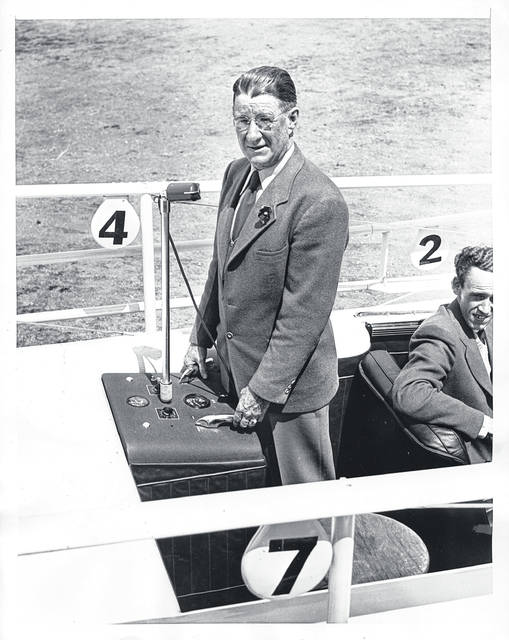
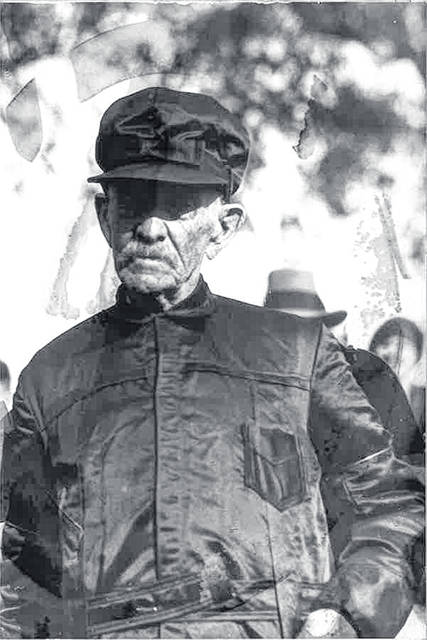
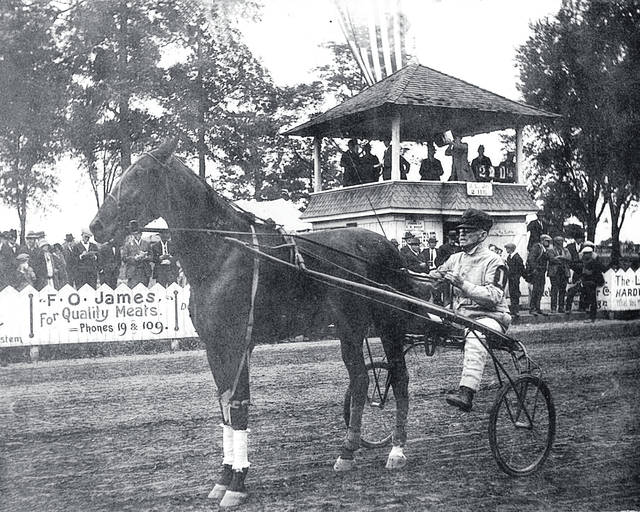
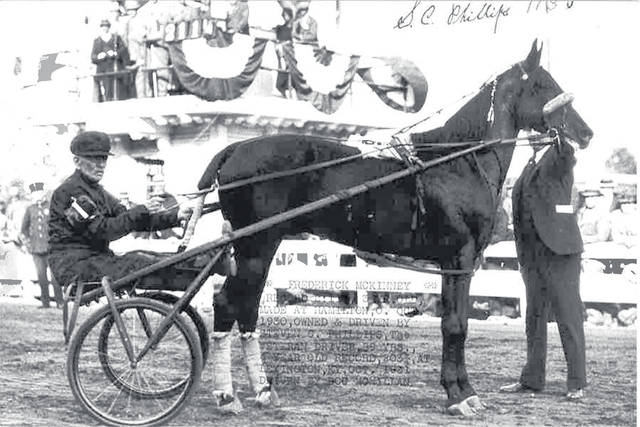
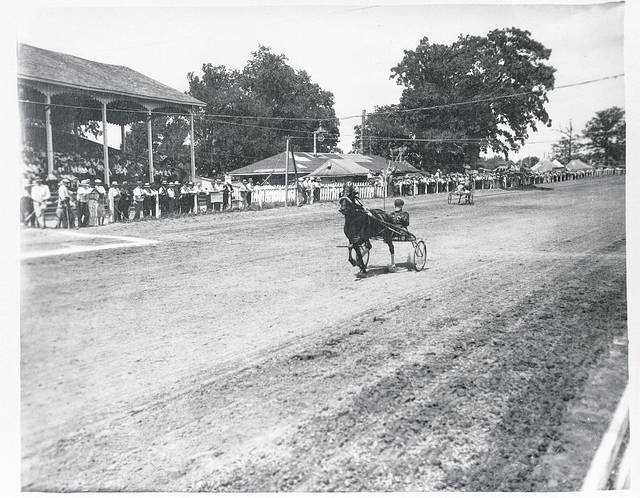
Saturday, May 8, 1880 was a bright sunny day in Washington Court House. A crowd had gathered on the courthouse square for the auction of 100 acres of choice farmland located just west of the city on the Wilmington pike near the Jamison Road intersection. The winning bidder was Stephen C. Phillips, whose rugged appearance belied the fact that he was 38 years old. He soon moved to Washington C. H. and continued his career as a celebrated harness horseman.
Phillips was born in Waynesville, Ohio, in 1842. Before coming to Washington C.H., he had lived most of his life in Greene County, Ohio. He had served with distinction as a Seaman in the U.S. Navy during the Civil War aboard ships named the Milwaukee, Elk and Monitor.
Stephen C. Phillips’ fame as a horseman began in 1879, when he campaigned his nationally famous gelding pacer, Sleepy Tom, who had several Greene County owners before Phillips bought him in 1878 for $320. The horse was 11-years-old. Sleepy Tom was a chestnut in color with pronounced white markings. Although Tom was nearly blind, he responded to Phillips’ verbal commands, which infused sentimentality and additional excitement into his races.
Pacers in the 19th century were rough-gaited. They bore out in an exaggerated fashion and often struck the wheels of their high-wheeled sulkies with their back feet, especially when negotiating the turns of racetracks. They were more apt than trotters to break stride in races to the aggravation of owners, trainers, and persons foolish enough to have bet on them.
In 1879, Sleepy Tom and three pacing rivals named Lucy, Mattie Hunter and Rowdy Boy fought memorable multi-heat battles over America’s mile racetracks at a series of high-profile meetings known as the Grand Circuit. Today, as in Sleepy Tom’s era, the Grand Circuit races are held sequentially in the summer and fall at the nation’s leading harness tracks to showcase the finest trotters and pacers.
According to the late John Hervey, harness racing’s most eminent historian, “The ‘Big Four’ really made pacing races popular and “the thing.” So brilliant were their contests, so uncertain were the heats split, and the excitement so tremendous, that their day became the “big day” wherever they appeared.” Sleepy Tom won 18 of 22 Grand Circuit races by having the best standing in the summaries. At Chicago in July 1879, he set a world pacing record of 2:12¼ for the standard distance of one mile. Sleepy Tom and Steve Phillips did more than any other horse and driver to popularize races for pacers, Hervey said.
Phillips sold Sleepy Tom in late 1879 and used the money from the sale to purchase the Wilmington pike farm where he bred, trained and sold Standardbred racehorses. His training headquarters became a gathering place for horsemen from near and far.
For most of his adult life, Stephen C. Phillips was known as Uncle Steve because of his wizened face, neatly trimmed beard and avuncular disposition. He lived more than 35 years in Washington C.H. and resided most of that time on South North Street. He had no children, and after his wife died in 1917, he moved to Lebanon, Ohio, to be nearer to nieces and nephews who lived in Warren County. Phillips’ popularity with Fayette Countians in all walks of life resulted in his election as Fayette County sheriff in 1900 and 1904 and as a Fayette County commissioner in 1910.
Uncle Steve was the driver of Bobby Burns, Fayette County’s famous sire of Standardbred racehorses, during the dapple gray’s brief and mediocre career on the racetrack in 1892 and 1893. It was Phillips who convinced brothers Wert and Roy Mallow that their 8-year-old buggy horse, Major Mallow, had the potential for becoming an exceptional racehorse. Wert and Roy sent Major Mallow to the races in 1906, after which the gelding pacer earned $30,940 during his seven years on the racetrack (the equivalent of nearly $800,000 in 2019 dollars).
Uncle Steve Phillips was a familiar driver at half-mile harness meetings throughout Ohio during the years he lived in Washington Court House. Among the cities where he regularly competed were Wellston, London, Lima, Canal Dover, Lebanon, Bucyrus, and Columbus for the Ohio State Fair. His most successful and well-known horses were the pacers Charley, The Candy, and Sugar Bob, the latter a gray son of Bobby Burns. In the 1920s, Phillips had considerable success with his trotter, Bingen Todd. He also owned the pacer Bay Wreath, who sired Frances Wreath, the dam of Ray Henley, Greene County’s outstanding half-mile-track pacer of the 1930s.
The racing program at the Fayette County Fair in 1932 featured the final appearance of Uncle Steve Phillips as a driver of harness horses. On Thursday, Aug. 18, 1932, 90-year-old Phillips donned his colors of somber brown for a free-for-all trot and pace contested in three heats.
Phillips drove his big bay trotter Frederick McKinney. The Washington C.H. Daily Herald captured the excitement of the occasion when it reported that “Uncle Steve got a thunderous ovation when he passed the grandstand for the start of the first heat, and the old familiar chorus of ‘Come on You Steve’ echoed across the fairgrounds after nearly a score of years.” Local horseman Ernie Smith won the first heat of the five-horse race with a pacer named Barney Google. San Guy, a trotter owned by the Fayette horseman Os Briggs, took the second dash with Earl Gault, Briggs’ trainer, in the sulky. Phillips finished fifth in the first dash and was fourth in the second one, but as the horses came out for the third and final heat, Frederick McKinney’s groom told some bystanders at the draw gate with a wink and a grin, “We’ll win this one.”
The Daily Herald recounted the finish of the third heat in these words: “Suddenly, the crowd broke loose with a chorus the likes of which had never before been heard from the old grandstand. Men, women, and children in a near-hysterical frenzy cheered for Uncle Steve.” The crowd watched Phillips urge Frederick McKinney swiftly, smoothly and dramatically past the other four horses 40 yards from the wire and win the mile heat in the respectable time of 2:13.
David S. Ingalls, the Republican candidate for governor of Ohio and the Navy’s only flying ace of World War I, presented Uncle Steve with a large easy chair on behalf of the fair board. A short time before, Ingalls had arrived at the fair in a blue and red airplane, which landed in a field on the Leesburg pike opposite the fairgrounds. Phillips sat in the chair on the racetrack in front of the grandstand while Ingalls made effusive remarks about the “Grand Old Man” of harness racing and spoke of their mutual service in the United States Navy. More deafening cheers followed.
Stephen C. Phillips died two years later on July 27, 1934 in Lebanon, Ohio. He was 92-years-old. He had been a hands-on horseman for 66 years. At his passing, newspapers throughout the nation called him the “dean of America’s harness horsemen.”
Stephen G. Phillips, a nephew of Stephen C. Phillips, was born and raised in Xenia. Stephen G. developed a love of harness racing while spending his boyhood summers with his Uncle Steve in Fayette County. The nephew began his career as a starter of trotters and pacers in 1910 at the age of 24. By 1917, he had become the starter at several Grand Circuit meetings, and he served as the Grand Circuit’s official starter for 26 years. In 1926, he sent the horses off and trotting in the first Hambletonian, a stake race for 3-year-old trotters that quickly became harness racing’s most prestigious event.
Over his 50-year career in harness racing, Stephen G. Phillips started races at more than 100 racetracks. Prior to his retirement in 1960, he started an average of 1,900 heats per year. In 1937, he designed the first successful mobile starting gate, which revolutionized harness racing by getting horses away on the first attempt and by eliminating the excessive scoring that tried the patience of racing fans. The summers that young Stephen G. Phillips spent visiting his uncle in Washington C. H. gave him strong ties to Fayette County and a place in its rich harness racing history. He died at Xenia, Ohio, in 1973 at the age of 86.
Stephen C. Phillips and Stephen G. Phillips are both enshrined as “Immortals” in the Harness Racing Hall of Fame at Goshen, New York. Uncle Steve was inducted into the Hall of Fame in 1974 and his nephew, Stephen G. Phillips, in 1978.






